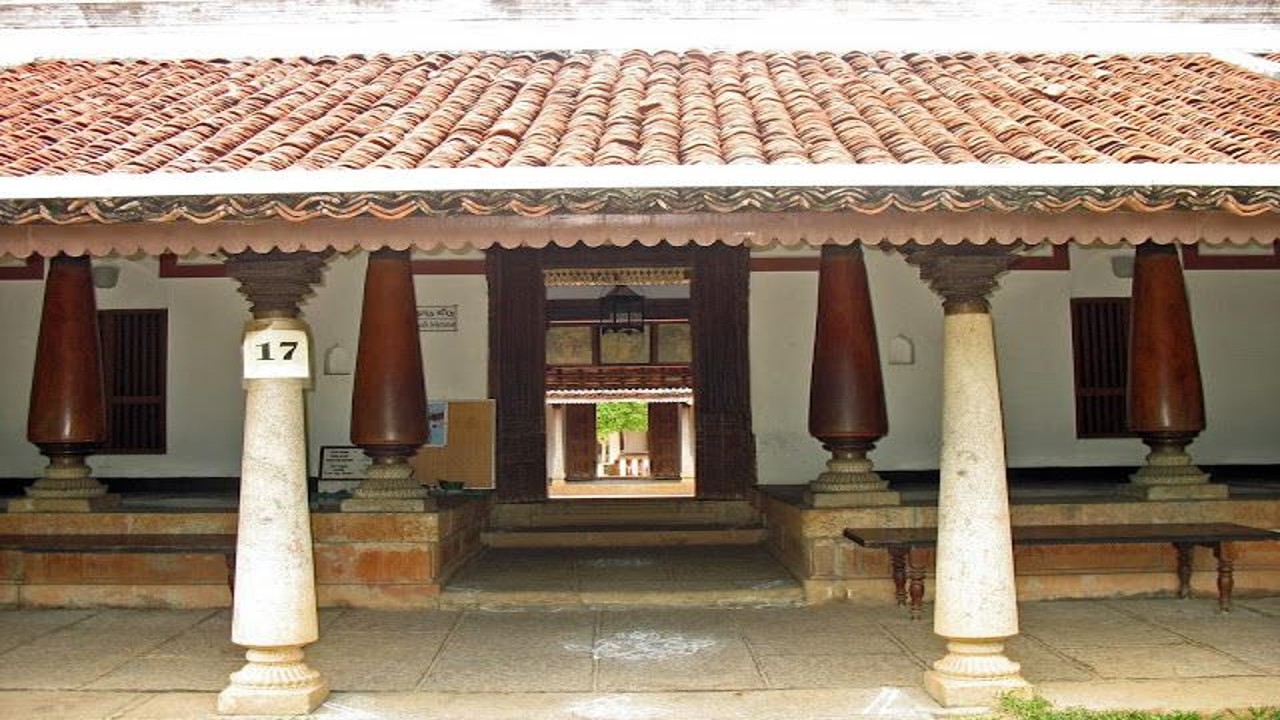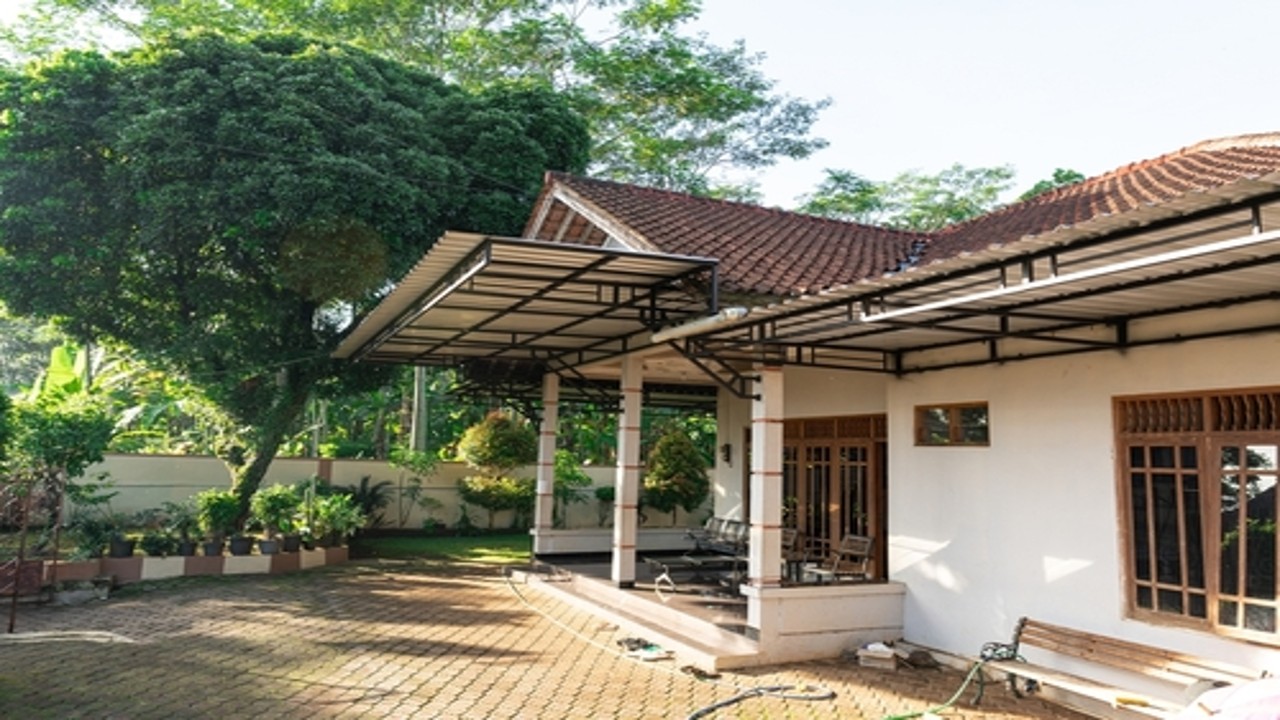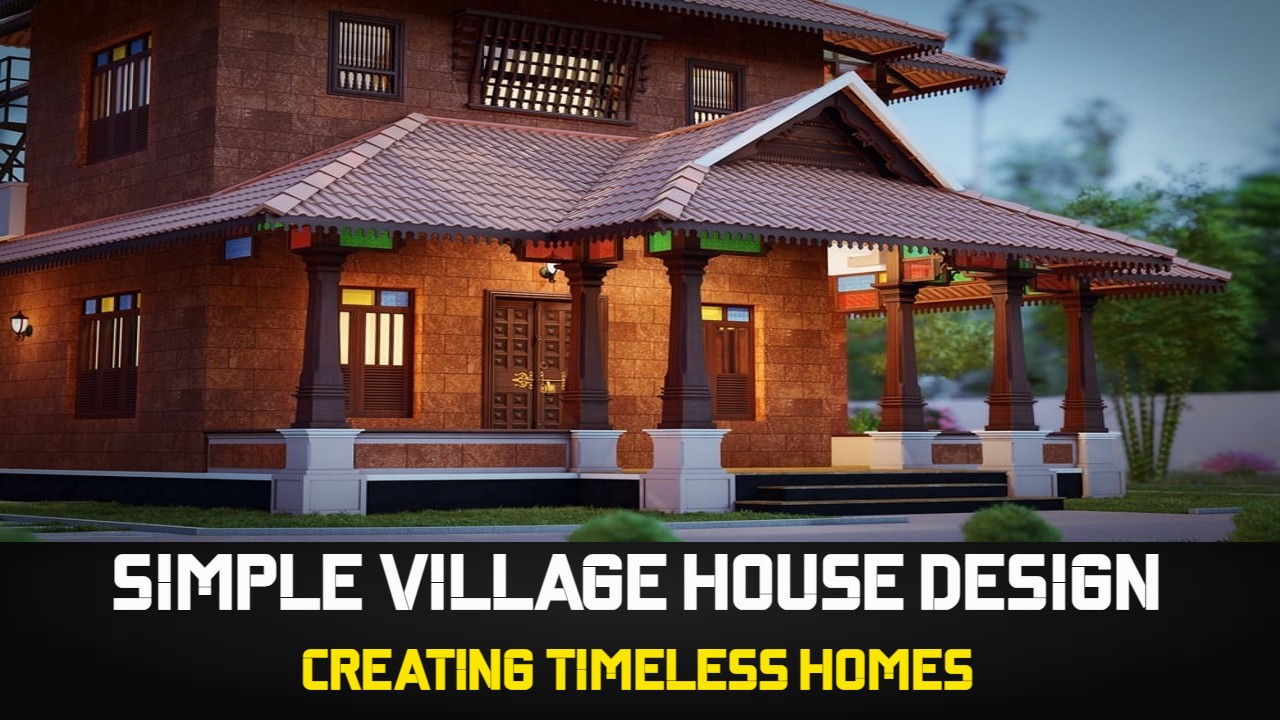India is a country with a rich tradition and a variety of architectural marvels. Every building, no matter how large or little, has a certain beauty and significance. The idea of basic village house design in India will be discussed in this article with an emphasis on making timeless dwellings that combine tradition with contemporary utility. This article will offer insightful information and suggestions, whether you’re seeking for motivation to build your ideal home or are simply enamored by Indian architecture’s stunning designs.
Contents
- 1 1. The Significance of Village Houses in India
- 2 2. Traditional Elements of Indian Village House Design
- 3 3. Simplicity and Functionality: Key Principles of Design
- 4 4. Materials and Construction Techniques
- 5 5. Efficient Space Planning for Small Footprints
- 6 6. Natural Ventilation and Lighting
- 7 7. Courtyards: Heart of Indian Village Homes
- 8 8. Harmonious Color Palette and Decorative Details
- 9 9. Modern Upgrades for Comfort and Convenience
- 10 10. Sustainability and Eco-Friendly Practices
- 11 11. Embracing the Cultural Heritage
- 12 12. Case Studies: Exemplary Village House Designs
- 13 13. The Role of Architects and Designers
- 14 14. Challenges and Solutions in Village House Design
- 15 15. The Future of Village House Design in India
- 16 Conclusion – Village House Design
- 17 Frequently Asked Questions – FAQs
1. The Significance of Village Houses in India
In India, people have a unique affection for village dwellings. They represent the community’s ideals, culture, and traditions rather than being just buildings. These homes were built to endure the test of time and offer refuge to future generations. Each component of the design tells a tale and represents the connection between the past and present.
The significance of village dwellings is profoundly ingrained in India’s cultural landscape. These homes are of utmost significance since they represent the traditional way of life and personify communal living.

Village homes are more than just physical structures; they are a representation of the beliefs, traditions, and practices that have been handed down over many years. They depict the people’ collective heritage physically and highlight the variety of architectural styles that can be seen throughout India.
The function that village homes play in promoting a sense of community and belonging is one of their most important contributions. These homes become the hubs of social interaction in rural settings where villages are close-knit communities. They offer areas where families may congregate, celebrate holidays, and take part in social activities. These homes’ architectural elements are intended to encourage community spirit and engagement among the residents.
The relationship that village homes have with the natural world and the environment is also significant. The majority of village homes are constructed from readily accessible local materials like clay, stone, and wood, which mix in beautifully with the natural surroundings. Utilizing natural resources not only assures sustainability but also contributes to keeping the ecosystem in balance.
Village homes are essential for maintaining cultural heritage. These homes frequently have distinctive architectural designs, fine carvings, and ornamental accents that pay homage to the local creative heritage. Communities may protect their cultural identity and pass it on to future generations by conserving and maintaining historic homes.
Additionally, village homes support rural communities’ economies. Local artisans, craftspeople, and construction workers who specialize in conventional building methods have employment options thanks to them. In turn, this supports regional economic growth and traditional handicraft.
Also Read: 22′ X 24′ House Plan | 3 BHK Ghar Ka Naksha | 528 sqft House Plan | House Design
2. Traditional Elements of Indian Village House Design
Indian village homes have a variety of customary components that pay homage to local aesthetics and architectural trends. These architectural features, such as sloping roofs and ornate carvings, give the dwellings personality and distinction. The utilization of locally accessible resources and building methods further increases the design’s authenticity.
Indian village house designs incorporate many traditional aspects, which give them character and cultural value. These components varies in various parts of India, reflecting the various architectural designs and regional customs. The following are some typical traditional components of Indian village home design:
Sloping Roofs

The majority of village homes in India have sloping roofs, which not only look nice but also have practical functions. The home is shielded from torrential monsoon rains by the sloping shape, which also aids in successfully channeling rainwater.
Ornamental Carvings
Indian village house architecture is known for its elaborate carvings. Both the outside and inside of the home are decorated with intricately carved motifs, patterns, and ornamental components made of wood, stone, or other materials.
Verandas and Balconies

Village homes frequently include roomy balconies or verandas that extend from the main building. Residents have access to these outdoor areas where they may unwind, mingle, and take in the scenery.
Courtyards
The design of Indian village homes must have courtyards. They operate as hubs of activity where families congregate to celebrate holidays and carry out daily tasks. A well or a small garden is frequently seen in courtyards, bringing nature closer to the living areas.
Open Layouts
Indian village homes frequently have open floor plans that encourage circulation and natural ventilation. The interiors are kept cool and pleasant thanks to this design, which is especially useful in hot and humid regions.
Use of Local Materials
Clay, stone, wood, and thatch are some of the locally accessible materials used to build Indian village homes. These materials assure the sustainability and longevity of the constructions while also blending in well with the surrounding environment.
Vibrant Colors
The interiors and exteriors of many Indian rural houses are painted in vivid hues. Bright colors are used to give dwellings a dynamic, upbeat touch that reflects the culture of the area.
Jali Work
Jali is the name for beautifully patterned wooden or stone latticework or screens. They frequently offer an aesthetic feature while allowing for ventilation and seclusion in windows, balconies, or walls.
Traditional Roofing Materials
The roofs of certain Indian village homes are composed of unusual materials, such as clay tiles or palm leaf thatched roofs. These materials act as insulation and support the maintenance of a cozy interior temperature.
Auspicious Symbols
Many fortunate symbols and motifs, such as religious symbols, geometric patterns, or pictures of deities, are included into the traditional Indian village home design. These symbols have cultural and religious importance and are thought to provide protection and good fortune on the locals.
Also Read: 20 Modern Kitchen Wall Tile Design Ideas for every Home Décor
3. Simplicity and Functionality: Key Principles of Design
Indian village home architecture is based on the guiding concepts of simplicity and utility. The focus is on designing functional living areas that meet the demands of the occupants. The designs are built for easy movement and maximum space use. The design removes pointless decoration and concentrates on crucial components that accomplish a task.
The village house design is based on the ideas of simplicity and utility. These guidelines center on developing functional and effective living areas that meet the demands of the occupants while respecting the cultural setting. Let’s explore the importance of functionality and simplicity in Indian village home design:
Practicality
Practicality is a key consideration in the village house design. The designs are tailored to utilize the available area as effectively as possible. The plan makes sure that the house can easily handle the tenants’ everyday activities while also taking into account their unique demands.
Space Optimization
Indian village homes sometimes have modest footprints, making effective space design necessary. To maximize the useable space, the design includes ingenious storage options, furniture that serves many purposes, and small layouts. Effective use of every space and nook creates productive areas.
Ease of Movement
Movement inside the home is prioritized in Indian village house designs. The design reduces barriers and guarantees seamless transitions between various locations. Wide entrances, wide hallways, and roomy common rooms all contribute to a smooth flow and improve the house’s overall operation.
Minimalism
An important aspect of Indian village home architecture is simplicity. The emphasis is on functional, vital features rather than pointless adornment. This approach to minimalism keeps utility intact while producing a neat and uncluttered look.
Cultural Relevance
Design simplicity frequently reflects the local cultural background. Simpleness, humility, and a connection to nature are cultural characteristics that are reflected in Indian village architecture. The architecture captures the customs and way of life of the area, resulting in houses that reflect the locals’ rich cultural heritage.
Cost-Effectiveness
The efficiency and simplicity of Indian village house designs also help them to be more affordable. Construction and maintenance expenses are minimized by eliminating superfluous features and concentrating on critical ones. As a result, these homes are accessible and reasonably priced for the rural communities.
Adaptability
Indian village house design are made to be flexible in response to shifting conditions and need. As the family expands or lifestyle needs change, alterations and additions are possible because to the adaptable floor plans and straightforward building methods. The house will always be current and useful because to its versatility.
Also Read: Installing PVC Vinyl Flooring in 6 Steps: A Comprehensive Guide
4. Materials and Construction Techniques
Depending on the geography and resources available, different materials are used to construct village homes in India. Brick, stone, wood, and clay are often used building materials. These materials not only add to the beauty but also provide durability and natural insulation. Local artisans use time-honored construction methods that have been passed down through the centuries to guarantee the structural integrity of the building.
5. Efficient Space Planning for Small Footprints
Working with a little amount of space is one of the difficulties in designing village houses. Indian designers and architects have perfected the art of effective space planning to fit all necessary functions into compact spaces. To maximize space without sacrificing comfort and functionality, multifunctional furniture, small storage options, and innovative room arrangements are used.
6. Natural Ventilation and Lighting
Due to the warm environment of Indian villages, natural lighting and ventilation are essential components of their architecture. Strategically positioned windows, skylights, and open floor plans encourage the movement of outside air and let in plenty of natural light. This decreases the need for artificial lighting and cooling systems and also makes for a more energizing and healthful living space.
Indian village home designs include natural ventilation and lighting as essential elements to create a comfortable and sustainable living space. Let’s look at how these components are used in the design to encourage airflow and rely on natural light:
Strategic Window Placement
In order to encourage cross ventilation, windows are strategically placed in Indian rural dwellings. Windows are positioned carefully to take advantage of prevailing breezes and promote the flow of fresh air throughout the home. This aids in keeping the inside cool and well-ventilated even in hot and humid weather.
Open Floor Plans
Indian village home designs frequently include open floor patterns that allow for unfettered ventilation. Without interior walls or barriers separating living rooms, air may travel freely and have a cooling effect. The advantages of natural ventilation are enhanced by this design strategy.
Ventilation Openings
In addition to windows, the design includes particular ventilation holes like ventilators or vents. These apertures are positioned in the walls or roofs at higher elevations to enable hot air to escape and create a stack effect that encourages air circulation. Warm air is expelled and colder air is drawn in from lower levels thanks to this process.
Courtyards and Atriums
Indian village home designs are characterized by courtyards and atriums, which serve as open areas that improve natural ventilation. These regions act as air pockets, allowing air to flow about the house. Additionally, they give people access to natural light, which illuminates the spaces around them and lessens the need for artificial lighting.
Skylights and Clerestory Windows
To capture natural light, clerestory windows and skylights are used. In order to brighten the interiors and lessen the need for artificial lighting throughout the day, these apertures are placed strategically on the roof or higher floors of the home. This not only conserves electricity but also produces a cozy and welcoming atmosphere.
Light Wells
Light wells, often referred to as light shafts or light courts, are vertical holes that pass through many levels and provide natural light into the central parts of the home. These wells assist in spreading the sun’s rays to lower levels, ensuring that even interior rooms receive enough natural light and decreasing the need for artificial lighting.
Shading Devices
To prevent the house from overheating from direct sunshine, the design includes overhangs, pergolas, and shade structures. With the help of these components, solar heat gain is decreased but diffused light still enters the areas. This harmony of shade and daylighting improves the home’s comfort and energy efficiency.
Also Check: Modular Kitchen and Carpenter Made Kitchen – Which is Best and Why?
7. Courtyards: Heart of Indian Village Homes
In Indian village house design architecture, courtyards are of utmost importance. They serve as places for families to congregate, celebrate holidays, and carry out daily activities. Courtyards serve as the heart of the home by bringing a sense of openness and connection to nature. These areas frequently have plants, water features, and other accents to add to the tranquil and welcoming environment.
8. Harmonious Color Palette and Decorative Details
Indian village homes’ color schemes are inspired by their environment and regional customs. To provide visual appeal and foster a peaceful mood, earthy tones, vivid accents, and complex ornamental elements are employed. Decorative carvings, paintings, and murals are typical elements that highlight the region’s workmanship and cultural legacy.
9. Modern Upgrades for Comfort and Convenience
While new improvements are included to improve comfort and convenience, historic design features are treasured. These additions, which range from modern bathrooms to modular kitchens, harmoniously fit with the entire scheme, striking the ideal balance between heritage and innovation. The quality of living is further enhanced by the use of energy-efficient systems.
10. Sustainability and Eco-Friendly Practices
Sustainable and environmentally friendly design principles have received more attention in recent years in village home construction. To construct ecologically conscious houses, architects and designers are adopting renewable energy sources, rainwater collection strategies, and green building materials. These eco-friendly measures not only lessen the environmental impact but also encourage a healthier and more environmentally friendly way of life.
11. Embracing the Cultural Heritage
Simple village house design in India are a representation of the nation’s rich cultural history in addition to being aesthetically pleasing. These homes become living museums that teach future generations about their ancestry and instill a sense of pride and belonging via the preservation and celebration of historic architectural features.
12. Case Studies: Exemplary Village House Designs
Inspiring examples of fusing tradition and contemporary can be seen in a number of outstanding village house designs in India. Every style, from the delicately crafted havelis of Rajasthan to the environmentally friendly bamboo homes in the Northeast, demonstrates the ingenuity and originality of Indian architects and their capacity to produce enduring dwellings.
Indian village house designs that stand out demonstrate the inventiveness, originality, and cultural diversity of the nation’s built environment. Let’s look at few case studies that present outstanding illustrations of Indian village house design:
Chettinad Mansions, Tamil Nadu
Chettinad houses, which may be located in Tamil Nadu’s Chettinad district, are famed for their opulence and architectural brilliance. These residences include elaborate woodwork, elaborate embellishments, and large courtyards. The design is made with more authenticity thanks to the usage of regional components like teak wood and Athangudi tiles. The lavishness and cultural history of South Indian architecture are best exemplified by the Chettinad houses.
Havelis of Rajasthan
The state of Rajasthan is home to historic mansion-style homes known as havelis. These architectural wonders, which have delicately carved facades, decorative jharokhas (balconies), and gorgeous paintings, exhibit great craftsmanship. The region’s architectural splendor is attested to by the havelis, which depict the luxurious way of life of the former Rajput nobles.
Thatched Roof Houses in Kerala
Traditional village homes with thatched roofs are a typical sight in Kerala’s backwaters. These dwellings, referred to as “Nalukettu,” are built using materials that are easily found nearby, such as bamboo, coconut palm, and mud. The open courtyard in the middle of the home provides for abundant natural light and ventilation. Homes with thatched roofs are the pinnacle of ecological architecture, integrating well with the tranquil surroundings.
Bamboo Houses in Northeast India
Bamboo homes are noted for being environmentally friendly in India’s northeast. Bamboo, a resource that is abundant and sustainable in the area, was used to construct these homes. Strong structures that resist the region’s climatic conditions are produced by the complicated weaving processes and expert craftsmanship. Bamboo architecture exemplifies the blending of ancient wisdom with cutting-edge environmental techniques.
Dokra Houses in Odisha
Dokra homes, which may be seen in Odisha’s tribal areas, are a prime example of the state’s distinctive tribal architecture. These homes are constructed of regional supplies including clay, mud, and cow dung. The exteriors are decorated with elaborate Dokra metalwork, a traditional tribal skill that gives them a unique aesthetic flair. Dokra dwellings embrace simplicity and sustainability while honoring the traditional traditions of the tribes.
These case studies are but a sample of the many excellent Indian village house design available. Each design captures the distinctive regional aesthetics, cultural quirks, and expert craftsmanship found throughout the nation. Indian village house designs continue to be an inspiration to designers and architects all over the world, reflecting the traditional Indian architecture’s ageless beauty and cultural importance.
13. The Role of Architects and Designers
The architecture of Indian village houses is greatly influenced by architects and designers. They play a key role in designing homes that are both practical and visually beautiful thanks to their knowledge, inventiveness, and awareness of cultural quirks. They realize the idea by working with regional craftspeople and artisans, making sure that every house has a distinct narrative.
14. Challenges and Solutions in Village House Design
Village house design are charming, but they also come with issues that must be resolved. Innovative solutions are needed because of the scarcity of resources, the desire for contemporary facilities, and changing lifestyles. To keep the homes current and flexible, architects and designers are discovering methods to strike a balance between upholding heritage and embracing modern demands.
15. The Future of Village House Design in India
India’s village house design will change much more as the country develops. Exciting opportunities lie in the convergence of sustainability, technology, and cultural preservation to produce homes that are not only aesthetically pleasing but also ecologically responsible and useful. The timeless village house design will continue to be influenced and shaped by the rich architectural legacy of India.
Conclusion – Village House Design
Designing a simple village house design in India involves balancing tradition, practicality, and cultural importance. These houses are a monument to the country’s inventiveness and rich architectural history. Every element of the design reflects the ideals and objectives of the community, from effective space planning to environmentally friendly methods. Architects and designers guarantee that the tradition of Indian village house design endures for future generations by building timeless dwellings.
Frequently Asked Questions – FAQs
Are village house design in India only found in rural areas?
No, In India, traditional populations have settled in certain metropolitan areas where you may still see rural dwellings.
Can I incorporate elements of Indian village house design into a modern home?
Yes, To bring a little of Indian aesthetics and cultural history into a modern home, you can incorporate traditional design features of village house design.
What are some key features of Indian village house design?
Some distinguishing characteristics of Indian village house design architecture are courtyards, natural ventilation, sloping roofs, and artistic carvings.
How can I make my home more sustainable using village house design principles?
Utilizing sustainable methods includes choosing eco-friendly materials, rainwater gathering systems, and renewable energy sources – village house design
Where can I find examples of village house designs in India?
Numerous books, websites, and architectural periodicals feature exceptional Indian village house design that might serve as an inspiration for your own work.






